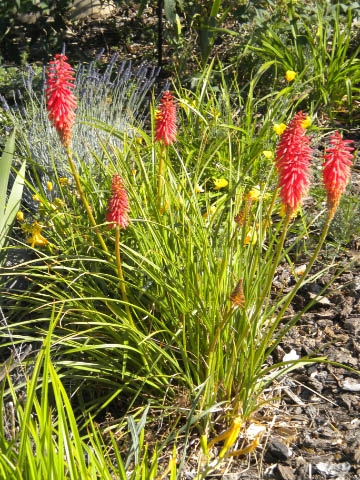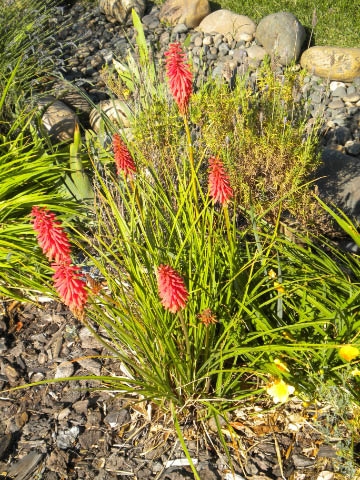Posts Tagged: hybrid
My Holy Grails
We all have a plant that we’re willing to sell the kids for (or at least rent them out). Does this sound familiar to you? I sometimes feel that ya can’t be a dedicated gardener without one “gotta have” plant. Well, my plants are 2 roses. I know, everybody on the block seems to sell roses. BUT I don’t desire any old rose; no sir, I have my heart set on 2 roses that are somewhere in the world, but where?
My quest, on and off for 30 years, started when a dear friend of my mother’s gave her a cutting of ‘McGredy’s Yellow’. This particular rose was introduced in 1934 the father of the present Sam McGrady and was advertised at the time as a “buttercup” yellow. Unfortunately, the writer of captions in The Ultimate Rose Book by Stirling Macoboy disputes this description and claims, “Light lemon yellow would be more accurate in cool climates; in hot, the color could be very pale indeed.” He then continues on about “the rose has deteriorated with age and it takes real skill to grow it to perfection.”
Not will to take the experts on head first, I can tell you that in Santa Rosa, CA, that cutting grew into a magnificent rose bush with butter colored, large blooms. Maybe the bush never read the “expert” review!
Forward on to twenty years plus- years ago. I started to live in Vallejo in a house with a totally non-descript yard. Green foliage plants sparsely planted – no color and no interest. I got a cutting from my mother’s rose bush and as it grew, planted in the front yard next to the porch. I received lots of compliments from the neighbors when it bloomed. By the way, this is considered to large flowered tea rose. In fact, the rose bush was a major selling point when we sold the house. Just one proviso from the buyer: DON’T TOUCH THE ROSE BUSHES, ESPECIALLY THE YELLOW ONE! Okey dokey, will do!
I figured I could always get another rose. WRONG! I have looked all over the internet: finally found two sources! Yea, the looking is almost over –NOT! Both sources: Beales in England and Vintage Gardens in Sebastopol, ca, appear to be gone! Beales never answered by emails (Peter has died) and Vintage Gardens is holding its going-out-of-business sale this month, limited to stock on hand.
Lucky for all of us that Darrell Schramm is a Master Gardener; he also belongs to the Heritage Rose Group. One of the members is running my plea to anyone for cuttings. My fingers are crossed.
Of course, I can go back to the old homestead and see if “my” rose bush is still there. But I don’t to be the crazy old lady having the hissy fit if it isn’t.
The other rose that I had to leave behind over 30 years ago is the ‘Sunset Jubilee’, another rose that is not in production anymore. Jackson & Perkins introduced it in the mid 60’s to honor Sunset Magazine. After a couple of years they renamed it and now positively state they never had such a rose with such a name even when confronted with an old copy of Sunset’s Rose Care Book with the rose on the cover. That search I’m saving for later!
Gesundheit!
I have always been impressed with the drama of hot pokers, Kniphofia. However several things held me back from purchasing them. First I don't like buying plants whose names I can't pronounce and Kniphofia ( knee fof ee a ) has had me stymied for a long time. When I was Googling Kniphofia, one of the first categories that came up was pronunciation, so I don't think I am alone. To me the name sounds like a sneeze; I get this uncontrollable urge to say "Gesundheit " every time I hear someone say it.
Secondly, most of the plants I have admired have been very large, with mounds of foliage reaching three to four feet high and sometimes five to eight feet wide and that's not even counting the blooms. I have a small front yard and a small border area available so I thought I would have to forgo a hot poker. (Note, in researching this article I found the most charming turn of phrase on the Digging Dog Nurserysite. Instead of calling a garden small, they called it space-thrifty.)
But then at Annie's Annuals I found Kniphofia 'Wol's Red Seedling'. This hybrid was carefully bred in England. Kniphofias are originally from South Africa, but were brought to England in the 1800s and are very popular there. This little darling has leaves that top out at a foot and flower spikes to two feet. It has a brilliant red color that is described by several sites as the reddest of all the pokers. They mentioned it could even be grown in a container. You guessed it, I brought one home.
I tucked it in the front yard in the border by the faux dry stream bed, amongst the 'Stella d'Oro' dwarf day-lilies and the lavender. The first summer it had three small blooms and I was a little discouraged. This year I have six blooms already, and the plant looks lovely, especially with the afternoon sun back-lighting it.
Kniphofias are deer resistant.They can handle clay soil, as long as it drains well. They are drought tolerant but do like water when the blooms are forming. If it is too dry at that point they will not bloom.

Kniphofia 'Wol's Red Seedling'. (photos by Karen Metz)

DSCN2663
Heirloom Seeds
Happy New Year 2012 to everyone! The parties are over, the leftovers are gone, and the weather is a little gray. What is a gardener to do? Well, there are some very wonderful seed catalogs available to spark your imagination and help you plan for a new year. They may even offer you the opportunity to plan for a spring or summer vacation centered on gardening events.
Two new catalogs for me both offer heirloom and open-pollinated seeds. An open-pollinated (OP) variety is one that breeds true from seed, meaning the seed saved from the parent plant will grow offspring with the same characteristics. OP seed is produced by allowing the natural flow of pollen between different plants of the same variety. Heirloom varieties are OP varieties with a long history of being cultivated and saved within a family or group. They have evolved by natural or human selection over time.
A hybrid variety, on the other hand, does not breed true from seed. Hybrid seed is produced by crossing two different parent varieties of the same species. Hybrids do not remain true in generations after the initial cross and cannot be saved from generation to generation unchanged. So if you like to save seeds from your favorite flowers or super sweet tomatoes, this is good to know.
As I was looking through the beautiful pictures in Seed Savers Exchange and Baker Creek Heirloom Seeds, I noticed that Crane melons were in each catalog. These melons bring back memories of my childhood in Sonoma County. The melons were introduced in the 1920’s by Oliver Crane whose family farmed six generations near Santa Rosa, California. The melon is a pear-shaped Crenshaw-type fruit that grows 3-5 pounds. The yellow green skin is covered in dark freckles and is ready for picking when the freckles turn orange. The light orange flesh has a great sweet flavor and takes 75-85 days to produce. Perhaps they will ripen even faster under Solano sun.
To get copies of the Seed Savers Exchange catalog from Decorah, Iowa go to www.seedsavers.org. The Baker Creek Heirloom Seeds can be found at www.rareseeds.com. Although Baker Creek is based out of Mansfield, Missouri, there is a seed store in Petaluma, called the Seed Bank, originally the first Bank of America building in town. Both catalogs have calendars of garden events for 2012 and even some free webinars that don’t require travel.

